Trinity Church: MIT Bids Farewell to Ellen Swallow Richards
Introduction
Text-to-speech Audio
Trinity Church and MIT have a long, intertwined history. In 1872, Boston's Summer Street Trinity Church was destroyed in the Great Fire. Following the fire, the congregation gathered in the Rogers Building‘s Huntington Hall every Sunday for five years until architect H. H. Richardson completed their new building. The new Trinity Church would be adjacent to the MIT campus.
Over the years, the church came to be MIT’s meeting house. It was the site of annual convocations and community gatherings. Following Ellen Swallow Richards’ death, everyone gathered at the Trinity Church for the memorial service on Sunday, April 2, 1911. She was a pioneer, educator, seeker, extremely hard worker, and a dear friend. Above all, she sought to be of service to her beloved husband, parents, students, friends, and colleagues.
Images
Photograph of Trinity Church and surrounding buildings in downtown Boston, 2008
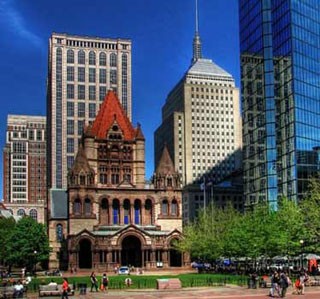
Old Trinity Church after the Boston Fire, 1872, looking southwest from Arch St.
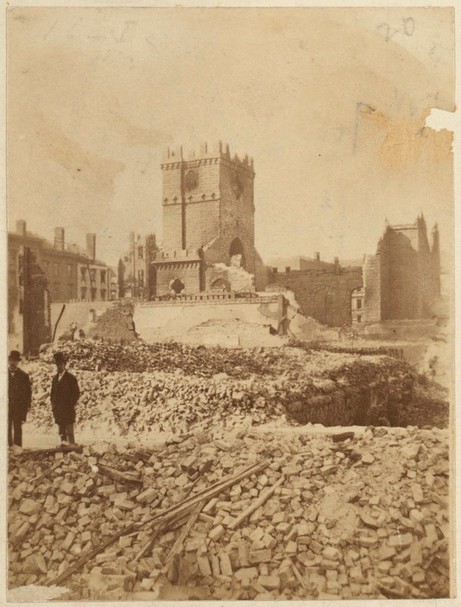
Trinity Church, Boston, after the fire of Nov. 1872
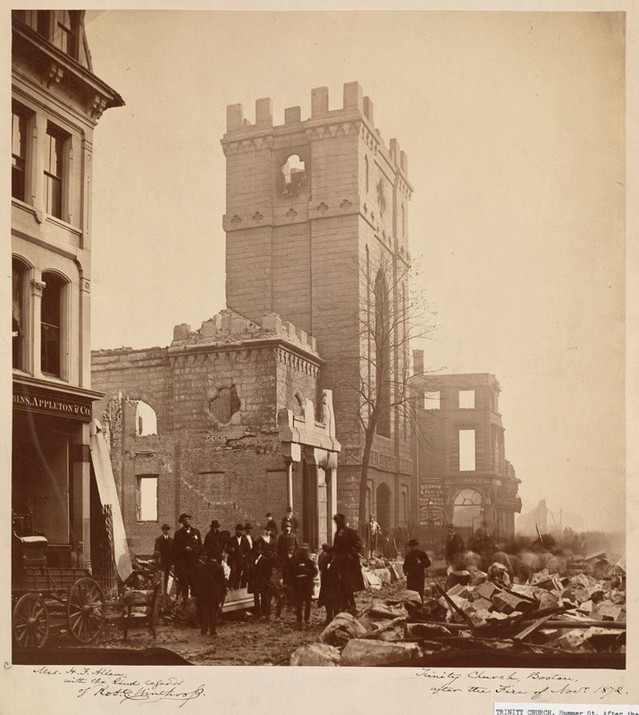
Panoramic view of the ruins after the great fire in Boston, from a point opposite Trinity Church in Summer Street, 1873.

The Rogers Building, Boston: Huntington Hall, 1889
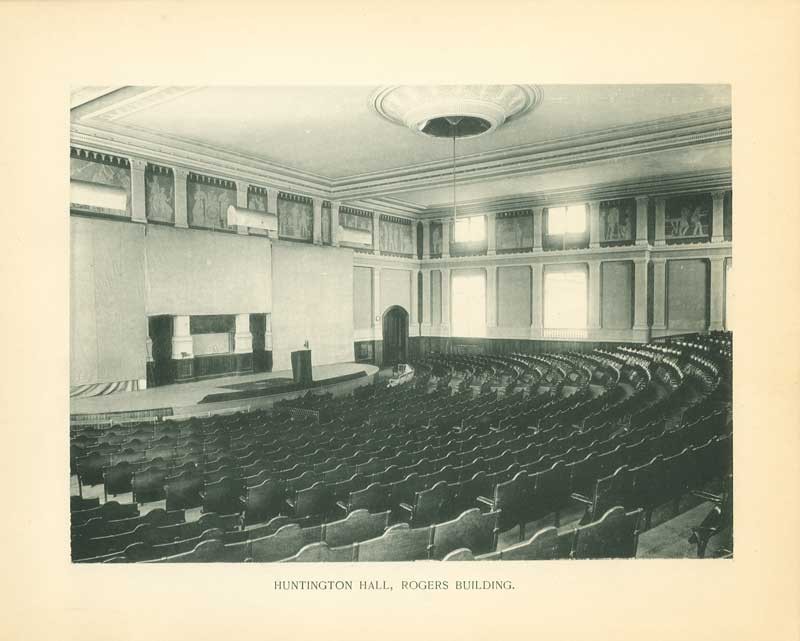
Ellen Henrietta (Swallow) Richards and Robert H. Richards, c. 1900. [1924 is not date of the picture]
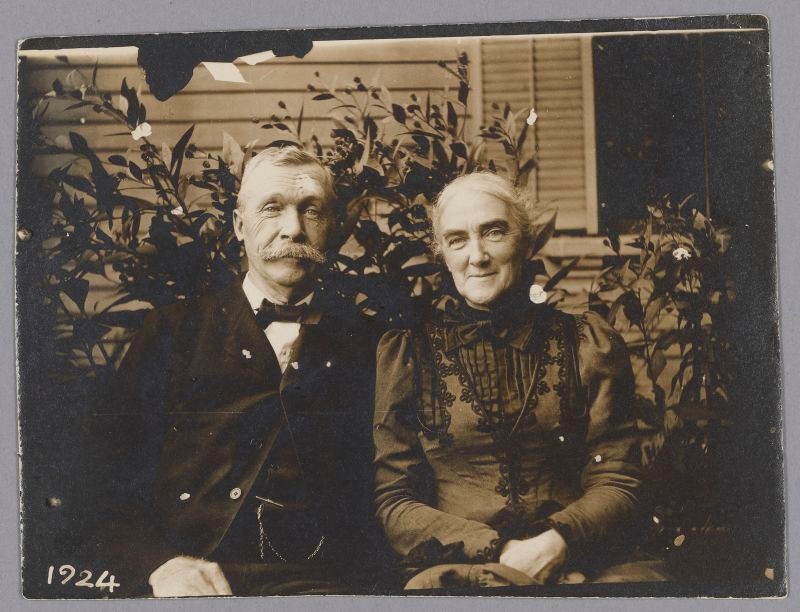
Ellen Henrietta (Swallow) Richards and Robert H. Richards on a country lane.
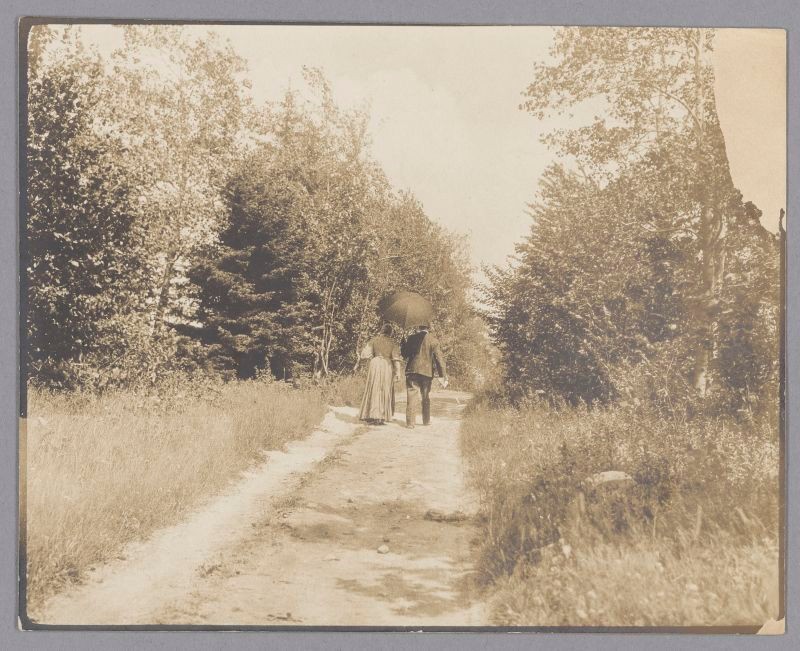
THE TECH, VOL XXX NO 139, April 26,1911
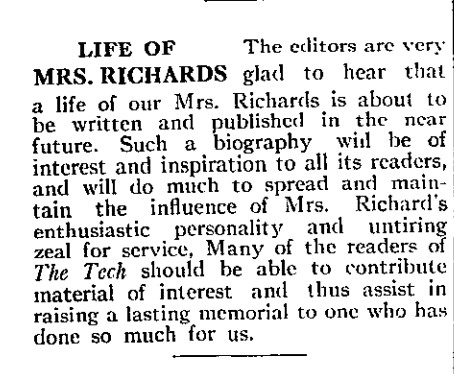
“Pioneer - Educator - Scientist - An Earnest Seeker - A Tireless Worker - A Thoughtful Friend – A Helper of Mankind.”
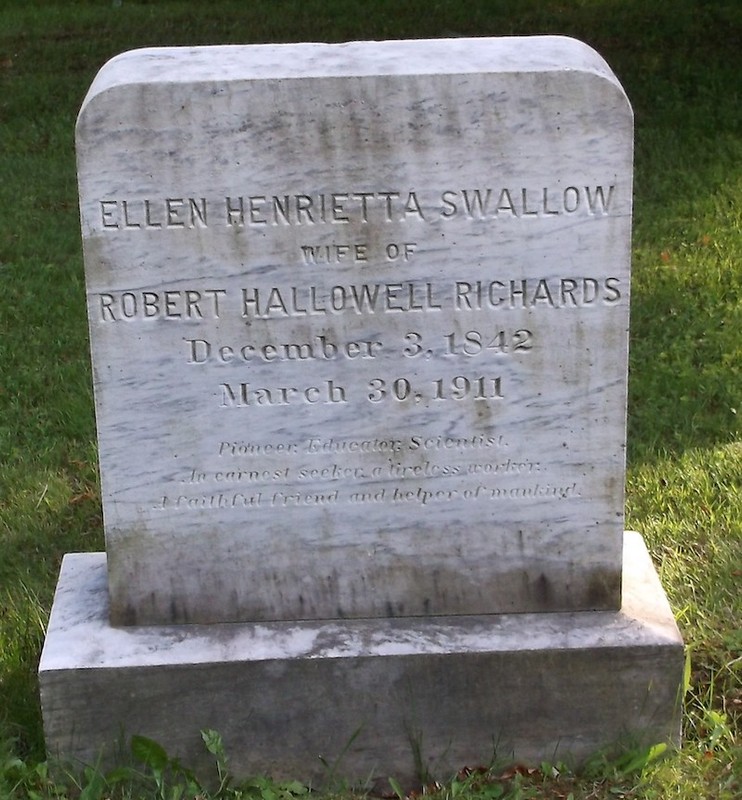
Backstory and Context
Text-to-speech Audio
Ellen was active in her laboratory up until the week before her death. Her husband was unaware of her suffering until the week she died “Always mindful of him and wishing him to have his thoughts free, she concealed from him the fact that she was suffering."[1] It was only on a Thursday night, the week before she died, that he learned something was wrong. “A physician was summoned and pronounced the trouble angina pectoris”[1]— a symptom of coronary artery disease and a type of chest pain caused by reduced blood flow to the heart. She died of her illness one week later on March 30, 1911.
On April 2, 1911, a funeral service was held at her home, 32 Elliot Street in Jamaica Plain, followed by “a public service at Trinity Church where the religious exercises of the Institute of Technology are held. Beautiful Trinity! And never more beautiful than that day when the chancel overflowed with the flowers she loved. At the close of the service, the casket was rolled to the west door of the church and those who gathered to do her honor saw her last bathed in the glory of the setting sun.”[1]
On that same evening, “a group of friends and co-workers of Mrs. Richards, several of whom had come from far distant places to attend her funeral, met at the College Club in Boston.
“Gathered together under the shadow of their great sorrow, they told each other what Mrs. Richards had done for them. Each had a characteristic saying of hers to repeat, or an anecdote illustrating her unfailing helpfulness to relate, but chiefly they spoke of how her call to them had always been in the direction of the large outgiving of life.
“Strangely enough the outlook even at that time, so soon after her death, was not backward, but forward. They asked even then what they could do to carry on the work that she had laid down. As the evening wore on, the suggestion was made that one way of doing this would be by giving permanent form to what had been said there so informally, and the hope was expressed that they and others who had known the inspiration of her personal influence might have an opportunity to show to the world as they had seen her.”[1]
In the closing sentences of the “Ellen H. Richards” chapter of Robert H. Richards’ autobiography, he wrote “There were many promoted over her head to assistant professor, associate professor, and full professor, but she never minded this at all. She was a true pioneer, and as a pioneer she did the only thing a pioneer can do, namely thank God for any favor or acknowledgment that came her way.”[2]
Robert Richards continues: “I have always liked the wording of the inscription which we put on Nellie’s tombstone at Gardiner [Maine]: “Pioneer - Educator - Scientist - An Earnest Seeker - A Tireless Worker - A Thoughtful Friend – A Helper of Mankind.”[2]
Historical markers call attention to select stories, but, as the 2021 National Monument Audit revealed, "the commemorative landscape is dominated by monuments to figures who would be considered white, male, and wealthy in our common understandings today," with monuments to men "grossly" outnumbering those to women.[3] Additionally, markers may be glossed over or fade into the background of daily patterns, as community members pass from one demand on their attention to the next; standalone signage or statues may fall short of prompting passersby to confront the historical underpinnings of their environment. By providing an experiential learning opportunity, the Association of MIT Alumnae (AMITA) “In Her Footsteps” Project walking tours acknowledge our indebtedness to the life-giving influence of Ellen Swallow Richards, MIT’s First Alumna.
Sources
- Hunt, Caroline Louisa, 1865-1927. The Life of Ellen H. Richards. Boston: Whitcomb & Barrows, 1912, https://hdl.handle.net/2027/uc2.ark:/13960/t3513ww21. Accessed 11 Mar. 2022.
- Richards, R. H. (Robert Hallowell). (1936). Robert Hallowell Richards: His Mark. Boston: Little, Brown, and Company.
- “National Monument Audit - Monument Lab.” Monument Lab, https://monumentlab.com/audit. Accessed 25 May 2023.
1. Trinity 2008. Courtesy of Peter Whelerton (Darwin70) on Flickr. Retrieved from MIT OCW - https://ocw.mit.edu/courses/11-337j-urban-design-policy-and-action-spring-2007/resources/11-337js07/. Accessed 25 May 2023.
2. Trinity Southwest. Digital Commonwealth. https://ark.digitalcommonwealth.org/ark:/50959/37720r28t. Accessed 25 May 2023.
3. Trinity Church. Digital Commonwealth.https://ark.digitalcommonwealth.org/ark:/50959/c821gq95k. Accessed 25 May 2023.
4. Panoramic. Frank Leslie's Publishing House, and Frank Leslie, photographer by Black, James Wallace.. Library of Congress. Spliced from https://www.loc.gov/resource/pga.03933/ and ../pga.03934/. Accessed 25 May 2023.
5. Huntington Hall. 1866-1938: Exhibits: Institute Archives & Special Collections: MIT.” Archive-It Wayback Machine, Photogravure Views of the Mass. Institute of Technology, Boston, 1889 https://wayback.archive-it.org/7963/20190702091720im_/https://libraries.mit.edu/archives/exhibits/rogers-building/img/huntington-hall.jpg. Accessed 25 May 2023.
6. Robert & Ellen: Courtesy of the MIT Museum, https://mitmuseum.mit.edu/collections/object/GCP-00024209. Accessed 25 May 2023.
7. Robert & Ellen walking. Courtesy of the MIT Museum, https://mitmuseum.mit.edu/collections/object/GCP-00024212. Accessed 25 May 2023.
8. The Tech. https://thetech.com/issues/30/139/pdf. Accessed 25 May 2023.
Grave: https://www.findagrave.com/memorial/16856339/ellen-henrietta-richards/photo. Accessed 25 May 2023.
